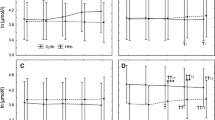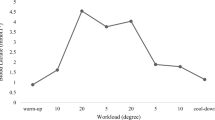Abstract
This review focuses on cerebral changes during combined exercise and heat stress, and their relation to fatigue. Dynamic exercise can elevate the core temperature rapidly and high internal body temperatures seem to be an independent cause of fatigue during exercise in hot environments. Thus, in laboratory settings, trained participants become exhausted when they reach a core temperature of ∼40°C. The observation that exercise-induced hyperthermia reduces the central activation percentage during maximal isometricmuscle contractions supports the idea that central fatigue is involved in the aetiology of hyperthermia-induced fatigue. Thus, hyperthermia does not impair the ability of the muscles to generate force, but sustained force production is lowered as a consequence of a reduced neural drive from the CNS. During ongoing dynamic exercise in hot environments, there is a gradual slowing of the electroencephalogram (EEG) whereas hyperthermia does not affect the electromyogram. The frequency shift of the EEG is highly correlated with the participants’ perception of exertion, which furthermore may indicate that alterations in cerebral activity, rather than peripheral fatigue, are associated with the hyperthermia-induced development of fatigue. Cerebral blood flow is reduced by approximately 20% during exercise with hyperthermia due to hyperventilation,which causes a lowering of the arterial CO2 pressure. However, in spite of the reduced blood flow, cerebral glucose and oxygen uptake does not seem to be impaired. Removal of heat from the brain is also an important function of the cerebral blood flow and the lowered perfusion of the brain during exercise and heat stress appears to reduce heat removal by the venous blood. Heat is consequently stored in the brain. The causal relationship between the circulatory changes, the EEG changes and the hyperthermia-induced central fatigue is at the present not well understood and future studies should focus on this aspect.







Similar content being viewed by others
References
Gisolfi CV, Mora F. The hot brain: survival, temperature, and the human body. 1st ed. Cambridge: MIT Press, 2000
Brinnel H, Cabanac M, Hales JRS. Critical upper levels of body temperature, tissue thermosensitivity and selective brain cooling in hyperthermia. In: Hales JRS, Richards DAB, editors. Heat stress: physical exertion and environment. Amsterdam: Excerpta Medica, 1987: 209–40
Hales JRS, Hubbard RW, Gaffin SL. Limitations of heat tolerance. In: Freghy MJ, Blatteis CM, editors. Handbook of physiology. New York: Oxford University Press, 1996: 285–355
Rowell LB. Human circulation: regulation during physical stress. New York: Oxford University Press, 1986: 363–406
Nielsen B. Effects of changes in plasma volume and osmolarity on thermoregulation during exercise. Acta Physiol Scand 1974; 90: 725–30
González-Alonso J, Calbet JA, Nielsen B. Muscle blood flow is reduced with dehydration during prolonged exercise in humans. J Physiol 1998; 513 (Pt 3): 895–905
Caputa M, Feistkorn G, Jessen C. Effect of brain and trunk temperatures on exercise performance in goats. Pflugers Arch 1986; 406: 184–9
Brück K, Olschewski H. Body temperature related factors diminishing the drive to exercise. Can J Sport Sci 1987; 65: 1274–80
Gonzalez-Alonso J, Teller C, Andersen S, et al. Influence of body temperature on the development of fatigue during prolonged exercise in the heat. J Appl Physiol 1999; 86 (3): 1032–9
Etnier JL, Landers DM. Brain function and exercise. Sports Med 1995; 19: 81–5
Ide K, Secher NH. Cerebral blood flow and metabolism during exercise. Prog Neurobiol 2000; 61: 397–414
Gandevia SC. Spinal and supraspinal factors in human muscle fatigue. Physiol Rev 2001; 81 (4): 1725–89
Edwards RHT. Biochemical basis of fatigue. In: Knuttgen HG, editor. Biochemistry of exercise. Champaign (IL): Human Kinetics, 1983: 3–28
Borg G. Simple rating for estimation of perceived exertion. In: Borg G, editor. Physical work and effort. New York: Pergamon, 1975: 39–46
Fuller A, Carter RN, Mitchell D. Brain and abdominal temperatures at fatigue in rats exercising in the heat. J Appl Physiol 1998; 84: 877–83
Walters TJ, Ryan KL, Tate LM, et al. Exercise in the heat is limited by a critical internal temperature. J Appl Physiol 2000; 89: 799–806
Nielsen B, Hales JRS, Strange NJ, et al. Human circulatory and thermoregulatory adaptations with heat acclimation and exercise in a hot, dry environment. J Physiol 1993; 460: 467–85
Nybo L, Nielsen B. Hyperthermia and central fatigue during prolonged exercise in humans. J Appl Physiol 2001; 91: 1055–60
Bigland-Ritchie B, Jones DA, Woods JJ. Central and peripheral fatigue in sustained maximum voluntary contractions of human quadriceps muscle. Clin Sci Mol Med 1978; 54: 609–14
Kent-Braun JA. Central and peripheral contributions to muscle fatigue in humans during sustained maximal effort. Eur JAppl Physiol 1999; 80: 57–63
Ftaiti F, Grélot L, Coudreuse JM, et al. Combined effect of heat stress, dehydration and exercise on neuromuscular function in humans. Eur J Appl Physiol 2001; 84: 87–94
Nybo L, Nielsen B. Perceived exertion is associated with an altered electrical activity of the brain during exercise with progressive hyperthermia. J Appl Physiol 2001; 91: 2017–23
Housh TJ, Perry SR, Bull AJ, et al. Mechanomyographic and electromyographic responses during submaximal cycle ergometry. Eur J Appl Physiol 2000; 83: 381–7
Saunders MJ, Evans EM, Arngrimsom SA, et al. Muscle activation and the slow component rise in oxygen uptake during cycling. Med Sci Sports Exerc 2000; 32 (12): 2040–5
Shinohara M, Moritani T. Increase in neuromuscular activity and oxygen uptake during heavy exercise. Ann Physiol Anthropol 1992; 11: 257–62
Gerdle B, Henriksson-Larson K, Lorentzon R, et al. Dependence of the mean power frequency of the electromyogram on muscle force and fibre type. Acta Physiol Scand 1991; 142: 457–65
Kupa EJ, Roy SH, Kandarian SC, et al. Effects of muscle fiber type and size on emg median frequency and conduction velocity. J Appl Physiol 1995; 79: 23–32
Nybo L, Nielsen B. Middle cerebral artery blood flow velocity is reduced with hyperthermia during prolonged exercise in humans. J Physiol 2001; 534 (1): 279–86
Nielsen B, Hyldig T, Bidstrup F, et al. Brain activity and fatigue during prolonged exercise in the heat. Pflügers Arch Physiol 2001; 442: 41–8
Nielsen B, Strange S, Christensen NJ, et al. Acute and adaptive responses in human to exercise in a warm, humid environment. Pflügers Arch Physiol 1997; 434 (1): 49–56
Nielsen B, Savard G, Richter EA, et al. Muscle blood flow and metabolism during exercise and heat stress. J Appl Physiol 1990; 69: 1040–6
Dubois M, Sato S, Lees DE, et al. Electroencephalographic changes during whole body hyperthermia in humans. Electroencephalogr Clin Neurophysiol 1980; 50: 486–95
Dubois M, Coppola R, Buschsbaum MS, et al. Somatosensory evoked potentials during whole body hyperthermia in humans. Electroencephalogr Clin Neurophysiol 1981; 52: 157–62
Reeves DL, Justesen DR, Levinson DM, et al. Endogenous hyperthermia in normal human subjects: I, experimental study of evoked potentials and reaction time. Physiol Psychol 1985; 13 (4): 258–67
Deboer T. Brain temperature dependent changes in the electroencephalogram power spectrum of humans and animals. J Sleep Res 1998; 7: 254–62
Nielsen B, Jessen C. Evidence against brain stem cooling by face fanning in severely hyperthermic humans. Pflugers Arch Physiol 1992; 422 (2): 168–72
Mustafa MK, Kogali YM, Gumaa KA. Central nervous system, blood clotting and respiratory function associated with heat stroke. In: Hales JRS, Richards DAB, editors. Heat stress: physical exertion and environment. Amsterdam: Elsevier, 1987: 277–88
Jasper H. The ten twenty electrode system of the international federation. Electroencephalogr Clin Neurophysiol 1958; 10: 371–5
Angyán L, Czopf J. Exercise-induced slow waves in the EEG of cats. Physiol Behav 1998 Jan 1; 64: 267–72
von Euler C, Söderberg U. The influence of hypothalamic thermoceptive structures on the electroencephalogram and gamma motor activity. Electroencephalogr Clin Neurophysiol 1956; 9: 391–406
Rowell LB, Blackmon J, Martin R, et al. Hepatic clearance of indocyanine green in man under thermal and exercise stresses. J Appl Physiol 1965; 20: 384–94
Rowell LB, Marx HJ, Bruce RA, et al. Reductions in cardiac output, central blood volume and stroke volume with thermal stress in normal men during exercise. J Clin Invest 1966; 45: 1801–16
Johnson JM, Rowell LB. Forearm skin and muscle vascular responses to prolonged leg exercise in man. J Appl Physiol 1975; 39: 920–4
Gonzalez-Alonso J, Mora-Rodriguez R, Coyle EF. Supine exercise restores arterial blood pressure and skin blood flow despite dehydration and hyperthermia. Am J Physiol 1999; 277 (46): H576–83
González-Alonso J, Calbet JA, Nielsen B.Metabolic and thermodynamic responses to dehydration-induced reductions inmuscle blood flow in exercising humans. J Physiol 1999; 520: 577–89
Madsen PL, Sperling BK, Warming T, et al. Middle cerebral artery blood velocity and cerebral blood flow and O2 uptake during dynamic exercise. J Appl Physiol 1993; 74 (1): 245–50
Jørgensen L. Transcranial doppler ultrasound for cerebral perfusion. Acta Physiol Scand 1995; 152 Suppl. 625: 1–44
Poulin MJ, SyedRJ, Robbins PA. Assessments of flow by transcranial doppler ultrasound in the middle cerebral artery during exercise in humans. J Appl Physiol 1999; 85: 388–97
Nybo L, Møller K, Volianitis S, et al. Effects of hyperthermia on cerebral blood flow and metabolism during prolonged exercise in humans. J Appl Physiol 2002; 93: 58–64
Kety SS, Schmidt CF. The nitrous oxide method for the quantitative determination of cerebral blood flow in man: theory, procedure and normal values. J Clin Invest 1948; 27: 476–83
Heistad DD, Kontos HA. Cerebral circulation. In: Shepard JI, Abboud FM, Geiger SR, editors. Handbook of physiology. Vol III. Bethesda (MD): American Physiological Society, 1983: 137–82
Cabanac M, White MD. Core temperature thresholds for hyperpnea during passive hyperthermia in humans. Eur J Appl Physiol 1995; 71: 71–6
White MD, Cabanac M. Exercise hyperpnea and hyperthermia in humans. J Appl Physiol 1996; 81 (3): 1249–54
Ide K, Pott F, Van Lieshout JJ, et al. Middle cerebral artery blood velocity depends on cardiac output during exercise with a large muscle mass. Acta Physiol Scand 1998; 162: 13–20
Ide K, Gulløv AL, Pott F, et al. Middle cerebral artery blood velocity during exercise in patients with atrial fibrilation. Clin Physiol 1999; 19 (4): 284–9
Nunneley SA, Martin CC, Slauson JW, et al. Changes in regional cerebral metabolism during systemic hyperthermia in human. J Appl Physiol 2002; 92: 846–51
Bryan RM. Cerebral blood flow and metabolism during stress. Am J Physiol 1990; 259 (28): H269–80
Yablonskiy DA, Ackerman J, Raichle ME. Coupling between changes in human brain temperature and oxidative metabolism during prolonged visual stimulation. Proc Natl Acad Sci USA 2000; 97 (13): 7603–8
Shevelev IA. Functional imaging of the brain by infrared radiation (thermoencephaloscopy). Prog Neurobiol 1998; 56: 267–305
Cabanac M. Selective brain cooling in humans: ’fancy’ or fact? FASEB J 1993; 7: 1143–6
Brinnel H, Nagasaka T, CabanacM. Enhanced brain protection during passive hyperthermia in humans. Eur J Appl Physiol 1987; 56: 540–5
Nybo L, Secher NH, Nielsen B. Inadequate heat-release from the human brain during prolonged exercise with hyperthermia [online]. Available from URL: http://www.jphysiol.org/cgi/reprint/2002.030023v1.pdf [Accessed 2002 Nov 1]
Blomstrand E. Amino acids and central fatigue. Amino Acids 2001; 20 (1): 25–34
Davis JM, Bailey SP. Possible mechanisms of central nervous system fatigue during exercise. Med Sci Sports Exerc 1997; 29 (1): 45–57
Acknowledgments
Our studies were partly supported by grants from Team Denmark. The authors have no conflicts of interest directly relevant to the content of this review.
Author information
Authors and Affiliations
Corresponding author
Rights and permissions
About this article
Cite this article
Nielsen, B., Nybo, L. Cerebral Changes During Exercise in the Heat. Sports Med 33, 1–11 (2003). https://doi.org/10.2165/00007256-200333010-00001
Published:
Issue Date:
DOI: https://doi.org/10.2165/00007256-200333010-00001




